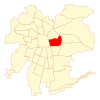Ñuñoa
| Ñuñoa | ||||||
|---|---|---|---|---|---|---|
| City and Commune | ||||||
|
Ñuñoa City Hall | ||||||
| ||||||
| Coordinates (city): 33°27.5′S 70°36′W / 33.4583°S 70.600°WCoordinates: 33°27.5′S 70°36′W / 33.4583°S 70.600°W | ||||||
| Country | Chile | |||||
| Region | Metro Santiago | |||||
| Province | Santiago | |||||
| Government[1] [2] | ||||||
| • Type | Municipal | |||||
| • Mayor | Andrés Zarhi Troy (RN) | |||||
| Area[3] | ||||||
| • Total | 16.9 km2 (6.5 sq mi) | |||||
| Population (2002 Census)[3] | ||||||
| • Total | 163,511 | |||||
| • Density | 9,700/km2 (25,000/sq mi) | |||||
| • Urban | 163,511 | |||||
| • Rural | 0 | |||||
| Residents by gender[3] | ||||||
| • Male | 73,215 | |||||
| • Female | 90,296 | |||||
| Time zone | CLT [4] (UTC-4) | |||||
| • Summer (DST) | CLST [5] (UTC-3) | |||||
| Area code(s) | 56 + | |||||
| Website | Municipality of Ñuñoa | |||||
Ñuñoa (Spanish pronunciation: [ɲuˈɲo.a]; from Mapudungun Ñuñohue, "place of yellow flowers") is a commune of Chile located in the Santiago province and city of Santiago. The oldest municipality in the traditional east end of Santiago, Ñuñoa has most city amenities (subways, banks, shopping areas, etc.) while still maintaining its character as a quiet, residential area.[6]
Recently, Ñuñoa's many charms and convenient location have led to an increased desire by young urban professionals to live there. In response, developers have bought out older homes and erected multi-dwelling units, a practice that has triggered much criticism from long-time residents.[7] In 2007, Ñuñoa was cited for the third consecutive year as the district with the highest quality of life in Santiago.

Ñuñoa boasts bustling public services and private businesses and a public transportation system serving all parts of the municipality. Most business activity takes place along Irarrázaval Ave., a 6-km thoroughfare crossing the entire municipality east-west. Ñuñoa is also home to Santiago’s only mosque and to the National Stadium, Chile’s largest sports complex. During the military dictatorship headed by Augusto Pinochet, the National Stadium, which stands in the heart of Ñuñoa, was turned into a notorious torture and death camp where tens of thousands were held. Every September 11, on the anniversary of the coup d'état that brought Pinochet to power, a candlelight vigil is held in remembrance of the scores of Chileans and people of many nationalities who were imprisoned, tortured and killed in the Stadium at the hands of their military captors.
Demographics
Per the 2002 census of the National Statistics Institute, Ñuñoa spans an area 16.9 km2 (7 sq mi) in size and has 163,511 residents (73,215 male and 90,296 female), making it a wholly urban area. The population dropped 5.3% (9,064 residents) from the 1992 to the 2002 censuses.[3] The 2009 population was projected to be 149,205.[8]
Stats
- Autonomous household income per capita: US$34,409 (PPP, 2006)[9][10]
- Population below poverty line: 4.3% (2006)[9]
- Regional quality of life index: 87.66, high, 1 out of 52 (2005)
- Human Development Index: 0.860, 6 out of 341 (2003)[11]
Notable residents
- Soledad Alvear, senator
- Gutenberg Martinez, politician
- Jorge Arrate, politician
- José Balmes, painter
- Fanny Pollarolo, former deputy
- Mercedes Valdivieso, writer
- José Miguel Varas, journalist
- Alvaro Diaz Arambulo, philosopher
- Fernando Villegas, writer and political commentator
- Alex Deferrari, musician
- José Luis Rosasco, writer
- Poli Delano, writer
- Orlando Ezquerra, musician
- Gerardo Parra, magus Oli
Administration
As a commune, Ñuñoa is a third-level administrative division of Chile run by a municipal council headed by a mayor elected to a four-year term of office. The mayor for 2016-2020 is Andrés Zarhi Troy (RN). The communal council has the following members:
- Guido Benavides Araneda (RN)
- José Luis Rosasco Zagal (RN)
- Juan Guillermo Vivado Portales (IND)
- Julio Martinez Colina (UDI)
- Jaime Castillo Soto (PDC)
- Paula Mendoza Bravo (PS)
- Patricia Hidalgo Jeldes (PPD)
- Alejandra Placencia Cabello (IND)
- Emilia Ríos Saavedra (RD)
- Camilo Brodsky Bertoni (IND)
Ñuñoa and Providencia make up the 21st electoral district, currently represented in the Chamber of Deputies by Maya Fernández (PS) and Mayor Sabat's daughter, Marcela Sabat (RN). Ñuñoa is also part of the 8th senatorial constituency (Eastern Santiago), represented in the Senate by Carlos Montes (PS) and Manuel José Ossandón (RN).
Education
Private schools:
Previously the area had a German school, Deutsche Schule Santiago-Nuñoa.[13]
References
- ↑ "Asociación Chilena de Municipalidades" (in Spanish). Retrieved 27 January 2011.
- ↑ "Municipality of Ñuñoa" (in Spanish). Retrieved 27 January 2011.
- 1 2 3 4 "National Statistics Institute" (in Spanish). Retrieved 13 December 2010.
- ↑ "Chile Time". WorldTimeZones.org. Retrieved 26 September 2010.
- ↑ "Chile Summer Time". WorldTimeZones.org. Retrieved 26 September 2010.
- ↑ Censo Comunal en ñuñoa (Spanish website)
- ↑ http://www.lanacion.cl/prontus_noticias_v2/site/artic/20070830/pags/20070830194512.html
- ↑ "System of Regional Information". Ministry of Planning of Chile (in Spanish). Retrieved 13 September 2010.
- 1 2 Casen poll, 2006, Ministry of Planning.
- ↑ Implied PPP conversion rate: World Economic Outlook Database, April 2010, International Monetary Fund.
- ↑ "The Trajectories of Human Development in the Communes of Chile (1994-2003)" (PDF). Government of Chile, Mideplán (in Spanish). UNDP. Retrieved 12 September 2010.
- ↑ Home page. Colegio Suizo de Santiago. Retrieved on April 25, 2016. "Dirección: José Domingo Cañas 2206, Ñuñoa, Santiago de Chile"
- ↑ "Deutscher Bundestag 4. Wahlperiode Drucksache IV/3672" (Archive). Bundestag (West Germany). 23 June 1965. Retrieved on 12 March 2016. p. 21/51.
External links
- (in Spanish) Municipality of Ñuñoa




